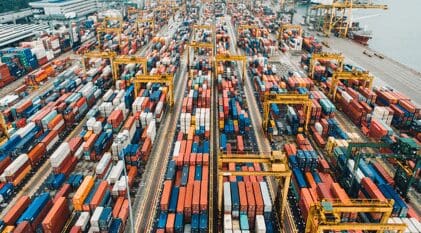Multichannel Systems for Distribution: The Details You Need to Know

The success of any business depends on its ability to deliver products to customers. And in most cases, that means using a single-channel sales system such as a brick-and-mortar store where you have a regular group of clients.
However, as your company becomes bigger, you may reach a limit to how much you can grow with only one place (or channel) for making sales. That’s where multichannel systems for distribution can be so beneficial.
When you expand the number of multichannel distribution opportunities, you can reach more customers and accelerate growth beyond what you could achieve locally.
But what are multichannel marketing systems? And what is the multiple channel distribution definition?
Let’s answer these and other important questions below.
What is a Multichannel Distribution System?
What is a Multichannel Distribution System? As a merchant and distributor of products, you probably have at least one distribution channel to generate sales. But with so many opportunities for reaching customers, having only one channel for distribution just doesn’t make a lot of sense.
That’s where multi-level distribution comes into play, offering different channels of distribution sellers can utilize to reach more customers and drive more sales.
Suppose you have a physical store and decide to implement a multi-channel retail strategy. In that case, you could expand your efforts online, opening an eCommerce store or even using online marketplaces like Amazon or eBay.
Another route would be to go to large retailers that could get your products on shelves in thousands of locations across the country, providing a massive boost to the number of customers you could reach.
Multichannel Distribution System Examples
To better understand how the multi-channel distribution definition looks in real life, it’s a good idea to look over a few examples of companies that have succeeded using this method.
The most obvious multichannel distribution system example that comes to mind is Starbucks. It’s a company with an incredible multichannel distribution strategy, with thousands of stores across the world and an online site where people can offer coffee.
The entire brand has been built on ease of access and convenience. As a result, Starbucks has become an experience that many people can’t envision their day without.
But we don’t need to look at huge multinational corporations to get an idea of how multichannel systems of distribution can be beneficial. For instance, if you have a local bakery that sells goods in a physical store, they might consider adding an online or phone ordering system to deliver the goods to the customer’s door. This way, they could avoid the long lines and enjoy the product in a more convenient way. At the same time, the seller would have an easier time keeping customers happy and could even reach customers that might not go to the physical store.
Benefits of Multichannel System
There’s a reason why a multi-channel distribution strategy is becoming more prevalent; businesses of all sizes can take advantage of the numerous benefits that it comes with. But what exactly can you expect if you implement a multichannel distribution system?
Let’s look at a few of the most powerful benefits.
- Happier customers. Your customers want convenience, and having the opportunity to buy your products using multiple channels is a vital part of the equation.
- More customers. At the same time, having multiple distribution channels means you can get in front of more customers.
- Increased stability. As a business, each additional distribution channel offers protection from fluctuations, keeping you covered even if one or two channels slow down.
Drawbacks of a Multichannel System
Even though multichannel systems for distribution are incredibly powerful, there can be some drawbacks if they are not implemented effectively.
Here are a few you should consider:
- Potentially higher costs. As you work with more distributors, you need to make sure that you have an effective way to fulfill orders. Otherwise, you may find that you will not just struggle to keep customers happy but will have to deal with much higher overhead costs as well.
- More room for error. At the same time, when you have multiple systems of distribution, you are dealing with a more complex operation that requires an excellent platform to manage everything in a single place. And if you don’t manage operations properly, avoiding errors will become virtually impossible.
How to Integrate a Multichannel Distribution Strategy Into Your Business Model
As a merchant and distributor of products, you probably have at least one distribution channel to generate sales. But with so many opportunities for reaching customers, having only one channel for distribution just doesn’t make a lot of sense.
That’s where multi-level distribution comes into play, offering different channels of distribution sellers can utilize to reach more customers and drive more sales.
Suppose you have a physical store and decide to implement a multi-channel retail strategy. In that case, you could expand your efforts online, opening an eCommerce store or even using online marketplaces like Amazon or eBay.
Another route would be to go to large retailers that could get your products on shelves in thousands of locations across the country, providing a massive boost to the number of customers you could reach.
Multichannel Distribution System Examples
Suppose you want to get the most out of using multichannel systems for distribution. In that case, you need to take a structured approach and consider how each channel will impact your overall operations.
For instance, you need to evaluate how each new channel fits with your products and whether the time and resources it would take to expand won’t conflict with the goals of your current channels.
In addition, you should strongly consider investing in a robust platform that can handle your orders and processes. For example, many companies opt for a direct-to-consumer fulfillment service that can ensure that customers receive their goods quickly, no matter what channel they were sold on.
Finally, continue evaluating performance to see which channels are delivering the results you expect. Sometimes, you may discover that a couple of conflicting channels cannibalize each other, and one of them might not be worth keeping.
Bottom Line
Multichannel systems for distribution can be a powerful way to scale your business and attract more customers. But when adding new channels, it’s essential to consider whether they will not negatively impact your current channels that deliver results.
At ShippingTree, we offer comprehensive eCommerce fulfillment software and services that provide coast-to-coast coverage on any channels you might use. Reach out today, and we’ll walk you through how ShippingTree can help!



